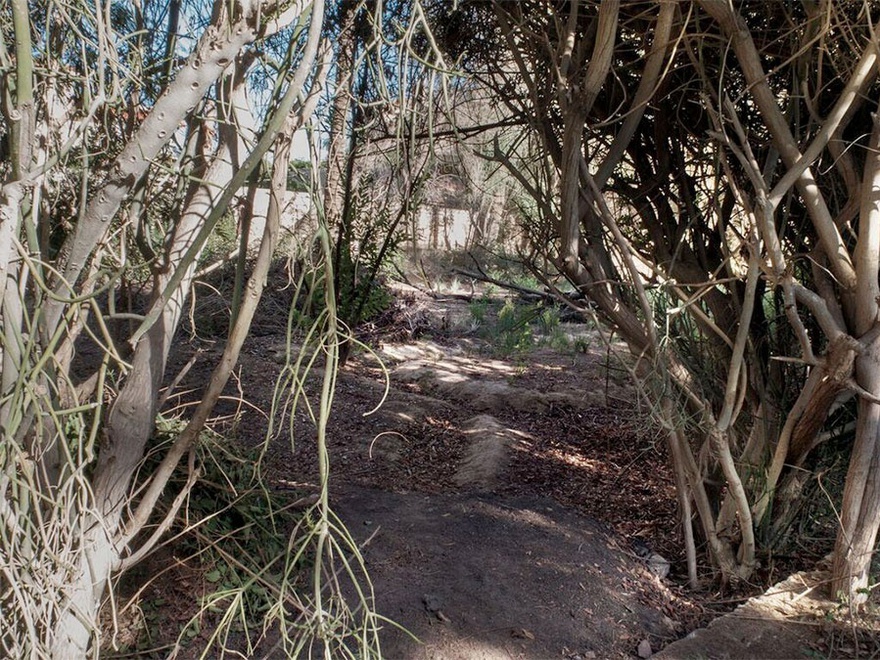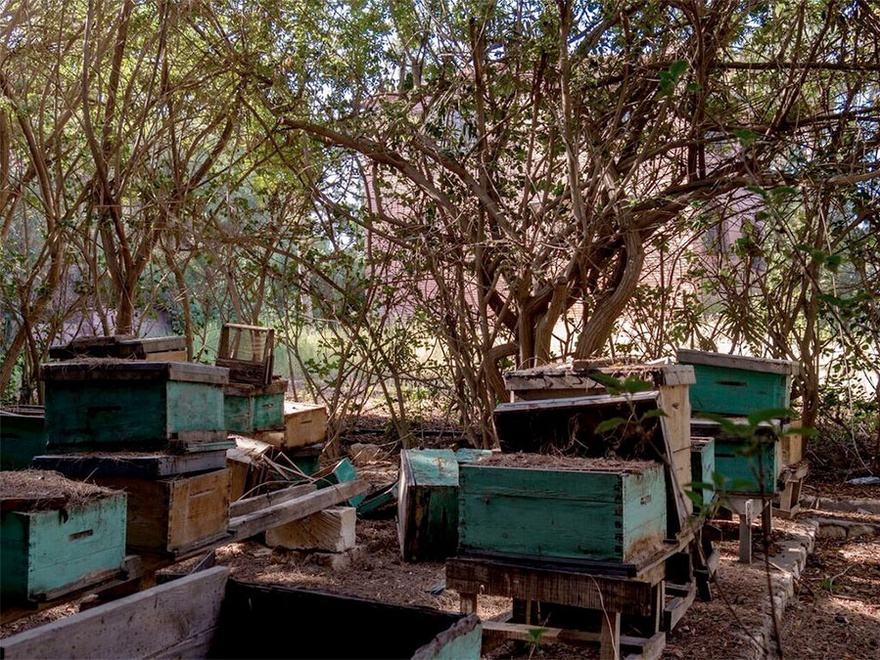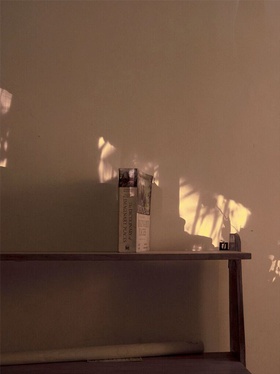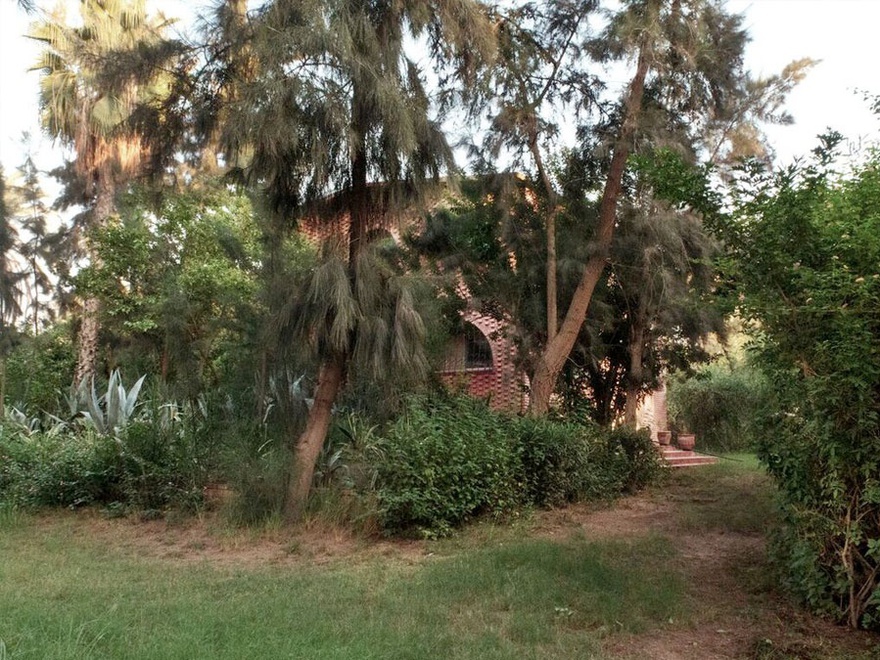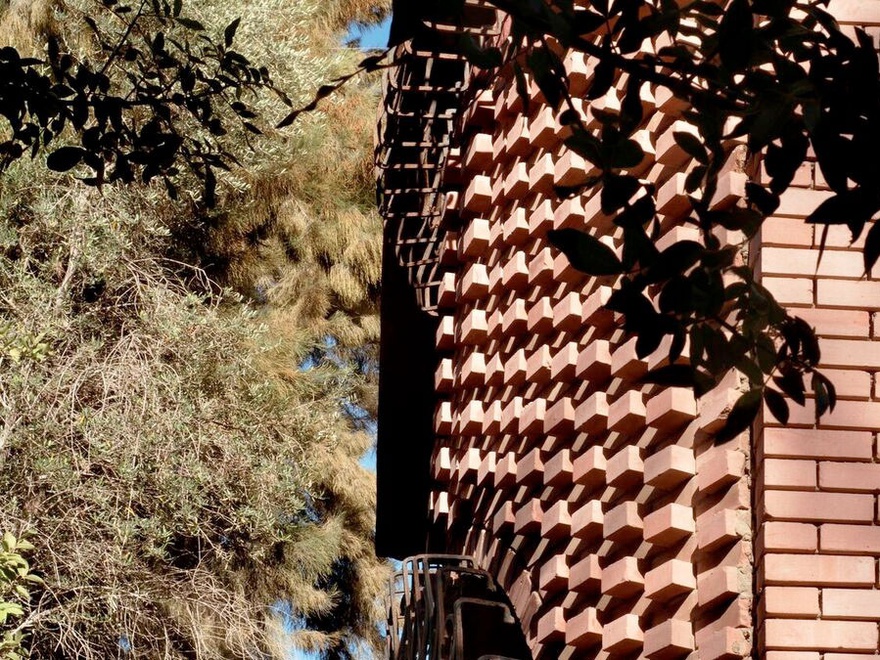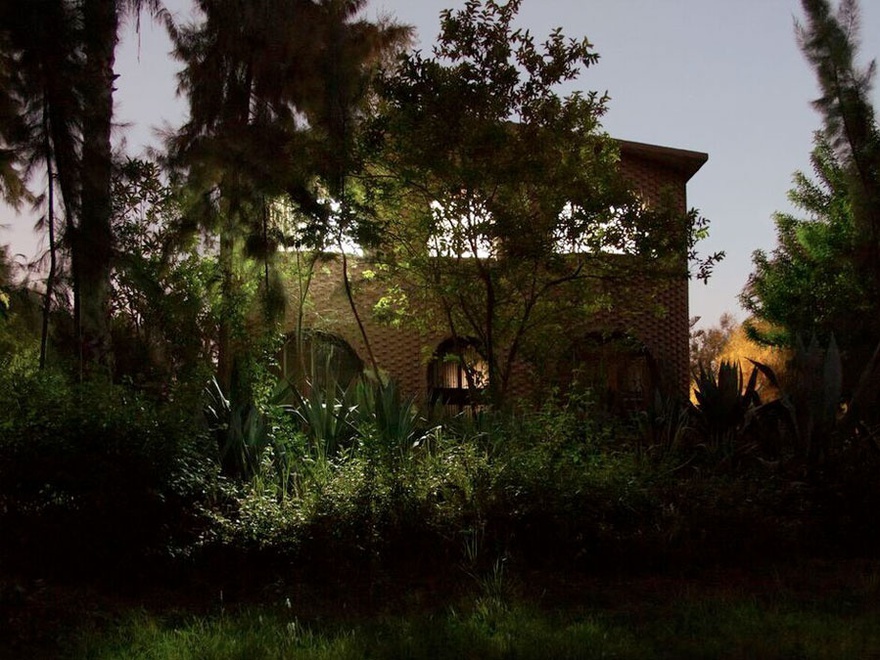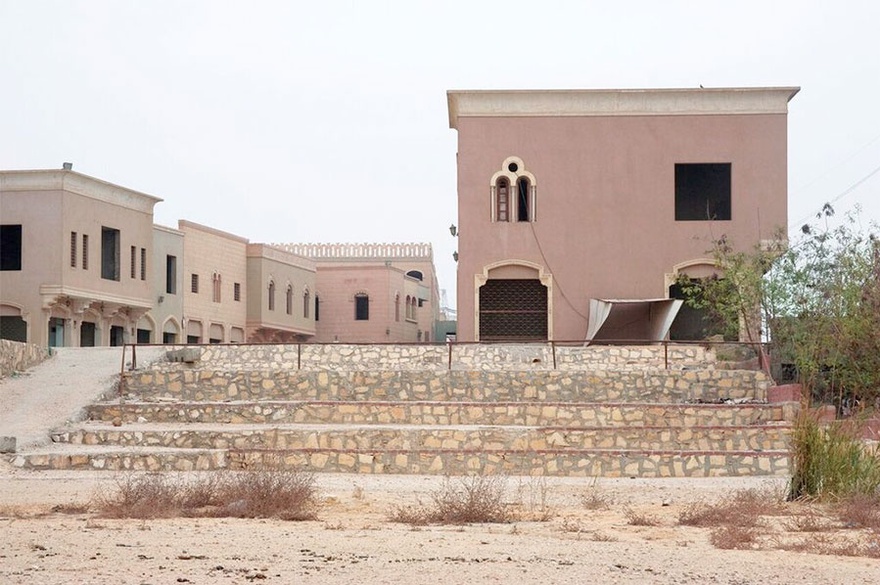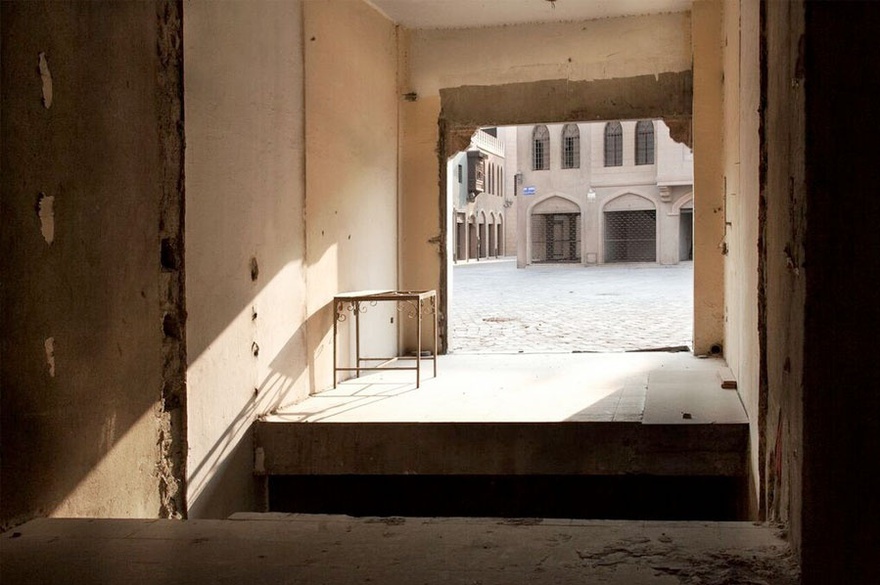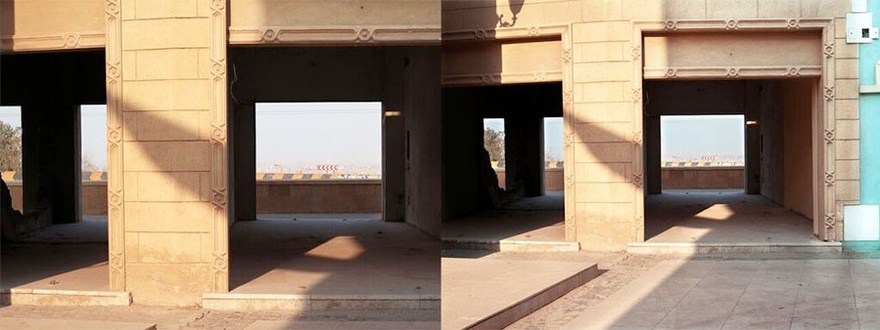Essays
Condemned to Depth
Invisible Architecture in Rana ElNemr’s Streams of Synonyms
But seeds are invisible. They sleep deep in the heart of the earth's darkness,
until some one among them is seized with the desire to awaken.
– Antoine de Saint-Exupéry, The Little Prince
The future is closer than it used to be, closer than it was last week, but postmodernity
remains an epoch of undead power: it's all over yet it carries on.
– Nick Land, Cybergothic
I'm looking at the buildings in Rana ElNemr's photographs,[1] pondering the roots of desire, the action of multicellular organs collectively carrying out a common function.[2] I'm recalling Nietzsche questioning of the origins of the Greek chorus: 'were there perhaps endemic raptures? Visions and hallucinations which entire communities, entire cultural bodies, shared?'[3]
There are building sites in Cairo reminiscent of mortuary architecture, seeking to resuscitate myth for an ever-renewed significance; obscure places where capital is suicided to enclose an erring soul. They have been called modernization projects. They will never be more than images.
Egypt's urban development conceals a deep existential schism: the desire symptomatic of economic apathy, pushing downward, into the burrows of opaque soil, the depth of romantic temporality where time bifurcates into dozens of intertwined origins. Architecture condemned to the depth of archaic desire, the muddle of skinless vulnerabilities and wandering affections at the mercy of encounter. I see it as the outgrowth of undead power, carrying on without function, as a repetition of gestures in a void, surviving tragedy, resigned to exist beyond dissolution, consumed in ritualistic speculation, or even irony, contingent on a mythicized future, becoming always in the past.
Rana ElNemr's A Chapter of Synonyms allows for such ravings to trail along her contemplations of urban changes as series of momentary events.[4] How does she capture a shape-shifting monster of a city that never becomes? What are her strategies in representing the invisible?
Surface / Process
A Chapter of Synonyms is the offshoot of a larger exhibition titled Assembled in Streams of Synonyms,[5] featuring works created between 2010 and 2016. A text on the wall outlines the project's inception:
[T]his show connects some of the main urban changes of recent years with the idea of architecture as a double projection. Architecture represents a 'project' of building, but it is also a projection in the sense of an imaginary exchange: a dialogue between real space and 'images'.[6]
A Chapter of Synonyms emerges as a bid for productive ambivalence, with a series of mental events occurring at 'the disjunction between images, films, sounds and texts.'[7] Paused at the same disjunction is the artist's own obsession with the possibilities of interpretation. At first glance, ElNemr's images appear to be hollowed impressions of architecture and vegetation, taken from liminal spaces evacuated of time in the drab aftermath of recoiled ambition. From unkept gardens to fragments of deserted buildings, photographs are taken from awkward angles, and are whimsically cropped. Like instances of haggard consciousness, their knowledge is ciphered. ElNemr's photographs are deliberately bland, so they can impart effortlessly to simultaneity, transparency and superimposition – the image of plant pots arranged diagonally on the hedge of a portico assume meaning next to an image of bricks fitted diagonally inside a wall. An imaginary exchange acknowledges the difficulty of an actual exchange between concrete reality and representation.
Every image is the product of private perceptions, relying respectively on the viewers' subjective awareness, engaged without a fixed point of reference in a 'game of substitution', where appearances ceaselessly change meaning as they travel through spheres of immanence. The artist calls those spheres synonyms, and they have a very specific function. ElNemr's symmetries, patterns and duplications, are a ceremonial withdrawal from profundity, the processes of narcissism and the violence behind any architecture, from the act of documentation toward a symbolic coherence of utterances. This withdrawal is articulated in two colour photographs that open the exhibition: The Map and The Dictionary of Imaginary Places. The first depicts the rough design of a garden, with names and places of plants scribbled in coloured markers on a white sheet of paper. The second is of Alberto Manguel's book of the same title, placed upright on a table, shut, distant, obscured in late afternoon shadows. Both images are faint propositions, setting the tone for a show that hounds its subject matter the same way concrete thought hounds the imaginary.
Next to these two images is a video: The Ministry of Squares and Roundabouts (2014). It shows the hands of a man neatly drawing tables in a notebook. On each page, there's the name of a square or a roundabout in Egypt, and we see him filling the tables with quantities and names of plants or trees to be placed in each one. Once finished, he signs and stamps the page with the municipality's seal. Together with The Map, the video becomes the reiteration of a principle of creativity: a mental process whereby an individual 'hones', orders and re-orders, an integrated worldview.[8] The video is seen as a concrete event inhabited by a concrete subjectivity finding fulfilment in potentiating a thought-process, 'the thinking of a possibility in the realization of which the respective subject finds its fulfillment'.[9] The Dictionary of Imaginary Places appears in this light as a pause: the incubation of potential caught in a moment of passing time.
The relations between various works and mediums form a matrix of concrete subjective possibilities, always referring back to mental processes. These possibilities have a functional determination as events, which are synonymous insofar as they incubate a processual form of thinking that in turn potentiates a possibility, and so on. This circularity evokes what Emmanuel Levinas defines as the great principle of phenomenology: 'The thought [le pensé] – object, theme, meaning – refers back to the thought [la pensée] that thinks it, but also determines the subjective articulation of its appearing: being determines its phenomena.'[10] Synonymy thus emphasizes a concreteness of mind, and offers a fluidity across concepts, transcending 'the naive abstractions of everyday consciousness, but also those of scientific consciousness, absorbed in the object, bogged down in the object.'[11]The phenomena engaged in constant activity are transparent to the eye, but present themselves directly to consciousness as events in progress.
This strategy denies the existence of image-truth altogether, and with it the chance for the image to ever be documentary; to represent space. For the viewer, the constant labouring of concrete thinking over imaginary relations means a commitment to the present moment coupled with a capacity for universality, attribution and reflection – as in finding the semantic link between books stacked precariously on a shelf and boxes stacked randomly in a garden.
Phenomenal transparency, as a deliberate vehicle of ambiguity, poses a trap for a subject constantly endeavouring to interpret what is seen and to make sense of its vacuity, if what is seen is essentially constructed through a process blind to its own frame. 'We don't see the window but only the bird flying by'.[12] We don't see our minds processing the images from embedded constructs but are only aware of appearances as they present themselves in the moment, entailing a phenomenal self made up of semantic spam and 'synonyms'. The trap consists of relying on subjectivity and simultaneously blocking it – invoking abstract processes while reiterating concreteness – a strategy that is highlighted by the introduction in this exhibition of a form of existence that is inherently blind to its processes as it disposes casually of the surface: the life of plants.
There's a lamppost in the art space, the only sculpture. The artist calls it The Living Object (2014). Its shaft goes through the ceiling, and its shielded luminaire dangles upside-down from a hooked arm. Inside the shield, sharing the space with a lamp and pushing in the opposite direction, are germinating seedlings of lentil, wheat, and arugula, sprouting quietly in the protective neon glow. The lamppost becomes an urban marker deactivated, serving instead as the incubator for the germination of plants. Nothing is produced from this encounter but a play of shadows: the third entity created from the collapse of (social) function into (plant) time. Next to the lamppost there is a speaker emitting the voice of Professor Mohamed Hamed Dowidar. He is describing the house he built in King Marriout (a compound off the city of Alexandria), detailing how he built it and why he later turned it into a local library. This audio is part of the series It became known that King Marriout now has a Library (2014). In his interview with the artist, Professor Dowidar speaks of his home like he would speak of a plant, describing it as something that has an innate wisdom: a structure growing and disappearing, germinating and decaying as part of its life cycle. Professor Dowidar seems to be concerned with the existentiality of architecture, its submission to nonintentional processes. In conjunction to his quivering narrative, the lamppost stands like a satirical object illustrating his aporia.
This paralleling of architecture and vegetation is the last consequence of the synonyms ElNemr articulates. As a primarily unrepresentable process operating on ambivalent temporality, architecture could be equivalent to vegetation, but not without risk. Vegetal architecture dispenses of the profundity lurking beneath all man-made surfaces. The profundity of social practices from which architecture is abstracted is the injustice which impregnates a space with ineffable intensity. What Louis Althusser refers to as the 'history heavy with gravity, materiality and finitude, with human suffering, discoveries, and joys'.[13] Architecture that is driven, like the seed of a plant, by the desire to 'push a charming little sprig inoffensively upward toward the sun,'[14] rids itself from an excess of stigma by disappearing like the bud 'in the bursting-forth of the blossom'.[15] While this correlation saves the medium of photography from obsolescence, it essentially proposes that (Cairo's) urban changes are a thing of the past, and their continuous existence is some form of idealism; 'The self-created sustenance of a mind / debarred from Nature's living images'.[16]
In ElNemr's work, we see images of buildings appearing from plant-like nonintentionality which 'boasts neither a self to which it could return, nor a fixed, determinate goal or purpose that it should fulfill.'[17] A superficiality which allows architecture to dispense of its visibility, becoming equal to an image, serving to reinstate 'the sovereignty of the present over what is already not and what is not yet.'[18]
Capital / Ideal
Under the auspices of zombie power, desire pushes downwards, creating a symbiosis between ideality and materiality. Whatever surfaces becomes an instant classic: dead on arrival it could never become. That could be a true source of power: an ongoing hypnotic appearance of progress. Architecture as incarnation of this artifice is neither deliberate nor social. An attitude towards affirming the collapse of materiality into the ravenous clutter of thought, designed to block consciousness, assisting the progress of zombification, serving as a symptom of undead power. This is something other than nihilism; the undead is decidedly anti-nihilist, omniscient and infinitely optimistic. It reproduces in the dark, from decay, like a plant, a plant-deity of sorts, or a Greek myth.
Development in Egypt, while reproducing all the infamous dynamics of social injustice, is rooted in this archaic desire – the metaphysics of Dionysian terror constantly exulting the present at the expense of function, logic and futurity. Rumi speaks of the phenomenal cage of not-being: 'This is the true religion. All others / are thrown-away bandages beside it.'[19]
I'm referring literally to religion. Not capitalism being analogous to a religion; but a tangible treatment of metaphysics in the capacity of money. A politics which places spirituality at the heart of everyday transactions, whereby value extracted from the governed subject is effectively sacrificial. A politics of depletion, existing essentially as a thought experiment, and an eternal process. Positing, in theory, an opposition to any form of materialism in which matter is anterior to thought or abstracted from social relations. The vicious abstraction as defined by Althusser in his elaboration on Marx's Capital: '[A] formula which is apparently abstract but really terribly concrete, because of the object it designates. This object is terribly concrete in that it is infinitely more concrete, more effective than the objects one can 'touch with one's hands' or 'see with one's eyes' – and yet one cannot touch it with one's hands or see it with one's eyes.'[20]
Egypt is indeed a concrete capitalist society in this sense, dominated by the invisible yet 'terribly concrete reality' of capitalist modes of production. Public sector development, however, continues to indulge in myth-building. One such project is Khan Al-Azizeya, a modernization effort undertaken during the Mubarak era in the 1990s as a replica of Khan al-Khalili, Cairo's oldest market. Located 22 kilometres into the Cairo-Alexandria desert road, Khan Al-Azizeya failed to lure craftsmen out of their ancient shops downtown. By the time ElNemr visited the site in 2010 to take the images shown in this exhibition, Khan Al-Azizeya was completely deserted. The TV advertisement filmed at the time of its development includes the refrain: 'Our aim is not to make money. Our aim is art, taste and beauty.' A marketing ploy that nevertheless highlights the tension between idealist duplicity and money. At the heart of this tension is the unwillingness to engage in an abstract exchange with money, but rather an idealist (deadlier) exchange with beauty, taste and art.
ElNemr's images of Khan Al-Azizeya are the most haunting of the Assembled in Streams of Synonyms. While reiterating the vacuity outlined above, their abstractness is of terrible concrete reality. They stand in isolation as fragments of buildings, in a sphere onto themselves, echoing each other and the blind desire behind their conception. Camouflaged as buildings, they emphasize a materialist process of a terribly concrete invisibility coupled with an idealist desire for decay. At this self-cancelling disjunction, the building of Khan Al-Azizeya are invisible, their images are images of geometrical comparisons.
Invisible architecture is alive even when it is dead. Throughout her photographic career, ElNemr has always looked with affection on such tragic and extraneous 'things', slowly transferring seriousness from ambivalent practices bred on the edges of Cairo, from the periphery, to the periphery of the periphery. The secondary truth that exceeds necessity no longer evokes the spectre of disaster but ventures wholly into ahistorical waste, the post-necessity stalemate of urban overdevelopment. We are shown a stillness that is no longer ambivalent, no longer contradictory. ElNemr mimics her affections and performs an idealism without space, as 'a practice of totalization', trying 'to obliterate any outside' and thus becoming 'pure outside'.[21] This is a momentary respite from contradictions, using plant temporality as a creative employment of time. Outside of both architecture and representation, on the limen, reiteration has a mission: to justify any exchange at all between urban planning and society, architecture and photography, and even art and society.
'When nostalgia is gone and waiting is over, one can delight in the superficiality of appearances', writes Mark Taylor in Erring: A Postmodern A/theology.[22] Surfaces offer the appearance of planning, and the appearance of thinking and development. Cairo's apathy is profound, ambivalent, and voracious; it devours people and disconnects them from their surroundings. It is those people, chewed up and shipwrecked, who are being asked to build it. But that is not, fortunately, what Rana ElNemr wants to imagine.
[1] Rana ElNemr is an Egyptian photographer and visual artist born in 1974, living and working in Cairo.
[2] See definition of 'Rhizoid', Wikipedia, The Free Encyclopedia, https://en.wikipedia.org/wiki/Rhizoid
[3] Friedrich Nietzsche, The Birth of Tragedy out of the Spirit of Music, tr.Ian Johnston, Vancouver Island University Nanaimo, British Columbia Canada, first published 1871, p. 6. See: http://www.holybooks.com/wp-content/uploads/Nietzsche-The-Birth-of-Tragedy.pdf
[4] A Chapter of Synonyms is curated by Marie Muracciole. It opened at Beirut Art Center (BAC) on 25 January 2017, and is on view until 26 March 2017.
[5] Assembled in Streams of Synonyms opened at Sharjah Art Gallery (American University in Cairo), from 30 November 2014 through to 15 January 2015.
[6] General wall text for A Chapter of Synonyms.
[7] Ibid
[8] See Liane Gabora,'Honing theory: A complex systems framework for creativity', in Nonlinear Dynamics, Psychology, and Life Sciences, 21(1) 2017, pp. 35-88.
[9] Reiner Wiehl, 'Process Philosophy and The Problem of Universals', in Subjectivity, Process, and Rationality, ontos verlag, 2007, p. 27. See: https://www.academia.edu/279956/Subjectivity_Process_and_Rationality
[10] Emmanuel Levinas, Entre-Nous, tr. Michael B. Smith and Barbara Harshav, Columbia University Press, 1998, p. 123.
[11] Levinas, p. 124
[12] Thomas Metzinger, Being No One: The Self-Model Theory, Massachusetts Institute of Technology, 2003, as quoted in S.C. Hickman, 'Thomas Ligotti: The Nemocentric Vision - the self as no-one and no-where' on Dark Chemistry, published online 18December 2010. See: http://earth-wizard.livejournal.com/47133.html
[13] reificationofpersonsandpersonificationofthings, Althusser on Abstraction. Posted on March 29, 2014, Translated by Ted Stolze. See: https://reificationofpersonsandpersonificationofthings.wordpress.com/2014/03/29/althusser-on-abstraction/
[14] Antoine de Saint-Exupéry, The Little Prince, tr.Katherine Woods, p.13. See: http://www.hilpro.com.br/wp-content/uploads/2015/11/Pequeno-Pri%CC%81ncipe-Ingle%CC%82s.pdf
[15] Wilhelm Friedrich Hegel, The Phenomenology of Spirit, originally published 1907. Quoted in Marder, Michael, Plant-Thinking: A Philosophy of Vegetal Life, Columbia University Press, 2013, p.97.
[16] William Wordsworth, The Prelude, Book Sixth, Cambridge and the Alps, 300. First published in 1850. See: http://www.bartleby.com/145/ww292.html
[17] Michael Marder, Plant-Thinking: A Philosophy of Vegetal Life, p. 153.
[18] Ibid. p. 96
[19] Rumi, The Book of Love, tr. Coleman Barks, Harper Collins e-books, p. 4. See:
[20] Louis Althusser, 'Preface to Capital Volume One', Lenin and Philosophy and other Essays, quoted inAlberto Toscano, 'Materialism Without Matter', Textual Practice, 2014,p.1235.
[21] Louis Althusser, Être marxiste en philosophie, quoted in Toscano, Alberto. 'The Detour of Abstraction', Diacritics, 2015/43.2, p. 75.
[22] Mark C. Taylor, Erring: A Postmodern A/theology, University Of Chicago Press, 1987, p. 16

